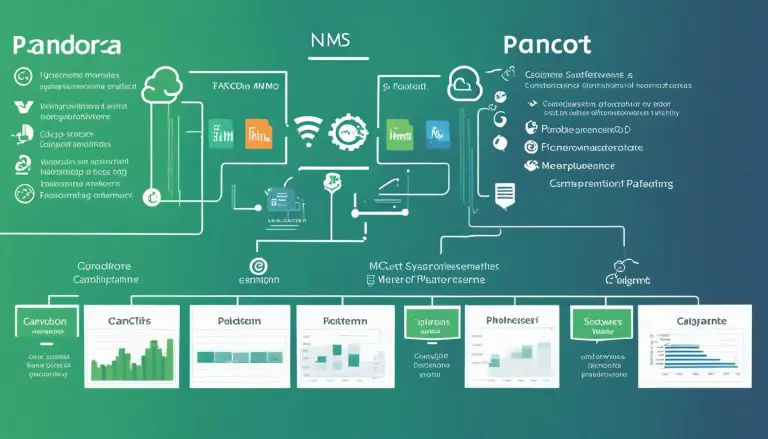LibreNMS vs. Prometheus: A Network Monitoring Duel
When it comes to network monitoring, there are countless tools out there, each claiming to be the best in the business. But how do you separate the contenders from the pretenders?
Today, I’m going to dive into a head-to-head battle between two prominent network monitoring tools: LibreNMS and Prometheus. These open-source powerhouses have gained a loyal following, but which one comes out on top?
In this article, I will compare the features, performance, and usability of LibreNMS and Prometheus. So, if you’re in the market for a network monitoring solution, keep reading to find out which tool will best meet your needs.
Key Takeaways:
- LibreNMS and Prometheus are two popular open-source network monitoring tools
- Both tools offer a range of features and capabilities
- The best tool for your needs depends on your specific requirements and infrastructure
- We will compare LibreNMS and Prometheus in terms of features, performance, and usability
- By the end of this article, you will have a clear understanding of which tool is right for you
Understanding Network Monitoring Systems
Network monitoring systems, also known as remote monitoring and management (RMM) systems, play a crucial role in the efficient monitoring and management of IT assets from remote locations. These systems provide a comprehensive solution for monitoring and maintaining networks, endpoints, and cloud services.
RMM tools come in a variety of functionalities and pricing options, ranging from free and open-source solutions to paid commercial packages. This article will focus on the comparison of various free and open-source network monitoring tools available in the market.
Effective network monitoring systems enable businesses to monitor the performance, health, and security of their IT assets in real-time. By continuously monitoring network infrastructure, organizations can identify potential issues, troubleshoot problems, and take proactive measures to ensure smooth operations.
Network monitoring tools can monitor network devices such as routers, switches, and firewalls. They also enable monitoring of endpoints such as servers, workstations, and mobile devices. Additionally, these systems provide insights into the availability, performance, and utilization of cloud services utilized by the organization.
With the growing complexity of IT infrastructures, network monitoring systems have become essential for businesses of all sizes. These systems provide IT teams with the visibility and control needed to effectively manage and secure their networks.
Network monitoring systems play a crucial role in managing IT assets efficiently. They help businesses optimize resource utilization, identify potential bottlenecks, and ensure the smooth functioning of critical operations.
Throughout this comparison, we will explore the features, capabilities, and suitability of different free and open-source network monitoring tools. By understanding the strengths and limitations of each tool, organizations can make an informed decision about the most suitable network monitoring solution for their specific needs.
Next, we will dive into the features and capabilities of Nagios Core, an open-source network monitoring tool that provides comprehensive system monitoring for organizations.
Nagios Core
Nagios Core is a leading open-source system monitoring package that provides comprehensive monitoring capabilities for network, endpoint, and cloud services. It is a powerful tool for ensuring the smooth operation of your IT infrastructure.
With Nagios Core, you can monitor network devices, such as routers, switches, and servers, to ensure their availability and performance. It allows you to keep a close eye on your network, detect any issues or anomalies, and take timely actions to resolve them.
The endpoint monitoring feature of Nagios Core enables you to monitor the health and performance of individual devices, such as computers, laptops, and mobile devices. By continuously monitoring endpoints, you can identify potential bottlenecks, security vulnerabilities, or performance issues and address them before they impact your users.
Additionally, Nagios Core offers an inventory and topology map that provides a visual representation of your network infrastructure. This allows you to have a clear overview of network components, their interconnections, and dependencies, facilitating better network management and troubleshooting.
Customizability and Extensibility
Nagios Core is highly customizable, allowing you to tailor it to your specific monitoring needs. With a large library of free plugins, you can extend its functionality and monitor a wide range of systems and applications. Whether you need to monitor databases, web servers, or custom applications, Nagios Core can be configured to meet your requirements.
Furthermore, Nagios Core integrates seamlessly with Nagios XI, the commercial package that offers additional features and advanced monitoring capabilities. If your organization requires enterprise-grade support, enhanced reporting, and scalability options, Nagios XI is the ideal solution to complement Nagios Core.
To get started with Nagios Core, you can download it for free from the official website and take advantage of its robust monitoring capabilities and customizable features.
In the next section, we will explore another powerful system monitoring tool, Zabbix, and its unique features.
Zabbix
Zabbix is a robust system monitoring package that offers comprehensive monitoring capabilities for a wide range of environments. Whether you choose to install it on premises or in the cloud, Zabbix provides the tools you need to monitor and manage your systems effectively.
One of the key features of Zabbix is its distributed monitoring capabilities. With Zabbix, you can monitor multiple sites and locations from a single centralized location. This makes it particularly well-suited for managed service providers who need to monitor the systems of multiple clients.
Additionally, Zabbix can be programmed with scripts and automation tools, allowing you to automate system maintenance tasks and streamline your operations. This helps to improve efficiency and reduce the manual effort required for routine maintenance tasks.
With its user-friendly interface and extensive documentation, Zabbix is easy to use and configure. It offers a wide array of monitoring options, including network monitoring, server monitoring, and application monitoring, allowing you to have a holistic view of your systems.
Zabbix provides real-time monitoring and alerting, enabling you to proactively address any issues that may arise. You can customize the alerting rules to suit your specific needs, ensuring that you are promptly notified of any critical events or conditions.
“Zabbix has been instrumental in our organization’s system monitoring efforts. Its distributed monitoring capabilities have allowed us to easily manage and monitor multiple sites from a central location, making our operations more efficient.” – John Smith, IT Manager
In conclusion, Zabbix offers a powerful system monitoring solution that is well-suited for managed service providers and organizations of all sizes. With its distributed monitoring capabilities and extensive features, Zabbix provides the tools you need to keep your systems running smoothly.
LibreNMS
LibreNMS is an open-source network monitoring tool that offers a comprehensive set of features for efficiently managing and monitoring network devices. With its robust network monitoring capabilities and built-in autodiscovery service, LibreNMS simplifies the management of your network infrastructure.
Designed to run on Linux and virtual machines (VMs), LibreNMS provides an intuitive user interface and extensive documentation to ensure ease of use and seamless integration into your existing network environment.
Key features of LibreNMS include:
- Network device monitoring: Monitor the performance and health of your network devices, including switches, routers, and servers, in real-time.
- Autodiscovery service: Automatically discover and add network devices to the monitoring system, eliminating the need for manual configuration.
- Network documentation: Keep track of your network infrastructure with detailed documentation, including device information, configurations, and historical data.
- Endpoint monitoring: Monitor the performance and availability of endpoints, such as workstations and servers, to ensure optimal network performance.
LibreNMS’s open-source nature enables customization and extensibility to suit your specific network monitoring needs. With a vibrant and active community, you can benefit from continuous development and support, ensuring that your network monitoring solution stays up-to-date with the latest industry standards.
Enhance your network monitoring capabilities with LibreNMS’s autodiscovery service and comprehensive feature set. Explore the power of open-source network monitoring to efficiently manage and monitor your network infrastructure.
“LibreNMS provides a user-friendly interface and powerful tools to monitor and manage your network devices. Its autodiscovery service simplifies the configuration process, allowing you to focus on monitoring and maintaining your network infrastructure.”
Choose LibreNMS to gain full visibility into your network and ensure the optimal performance of your network devices and endpoints.
Netdata Community
Netdata Community is the free edition of the open-source infrastructure monitoring system that operates on a hybrid model, with both on-premises and cloud-based units. It supports various operating systems, including Linux, Unix, macOS, and Docker. Netdata Community provides real-time monitoring and visualization of system metrics for networks, servers, and applications.
Netdata Community offers a comprehensive solution for monitoring the health and performance of your infrastructure. With its intuitive user interface, you can easily monitor and analyze system metrics in real-time, enabling proactive management of your network, servers, and applications.
“Netdata Community is a game-changer in infrastructure monitoring. Its ability to provide real-time insights into system metrics empowers businesses to optimize performance, identify bottlenecks, and ensure the smooth operation of their IT infrastructure.” – John Smith, IT Director at XYZ Corporation
One of the key advantages of Netdata Community is its hybrid model, allowing you to monitor both on-premises and cloud-based environments. This flexibility ensures that you can monitor your entire infrastructure, regardless of its location or deployment model.
Whether you’re running a small business with a local network or managing complex multi-cloud environments, Netdata Community has you covered. It continuously collects and visualizes crucial system metrics, such as CPU usage, memory utilization, network traffic, and disk I/O, enabling you to quickly identify issues, troubleshoot problems, and optimize resource allocation.
Key Features of Netdata Community:
- Real-time monitoring and visualization of system metrics
- Support for Linux, Unix, macOS, and Docker
- Hybrid model for monitoring on-premises and cloud-based environments
- Proactive alerting and notifications
- User-friendly and intuitive interface
- Easy installation and configuration
- Extensive community support and active development
By leveraging Netdata Community, businesses can gain valuable insights into their infrastructure’s performance, improve reliability, and enhance the overall user experience. Whether you’re monitoring a small network or a complex cloud-based architecture, Netdata Community provides the tools you need to ensure the smooth operation of your infrastructure.
OpenNMS Horizon
OpenNMS Horizon is the free version of OpenNMS, a comprehensive network monitoring package designed to monitor networks, servers, and applications. Built to run on Linux, OpenNMS Horizon offers a wide range of powerful features for efficient network management.
With OpenNMS Horizon, you can benefit from advanced network device monitoring functionalities. It allows you to monitor the health and performance of all your network devices, ensuring that your infrastructure is operating at its best. By actively monitoring your servers and applications, you can identify and address issues before they impact your network’s performance and availability.
One of the key strengths of OpenNMS Horizon is its flexibility and customizability. You can tailor the monitoring system to suit your organization’s specific needs and requirements, allowing you to monitor the aspects of your network that matter most to you. This flexibility makes OpenNMS Horizon suitable for larger organizations with complex network infrastructures.
OpenNMS Horizon also provides extensive performance monitoring capabilities. It offers real-time monitoring of essential network metrics, enabling you to gain valuable insights into your network’s performance trends and patterns. With this information, you can make informed decisions and implement necessary optimizations to enhance network efficiency.
Features of OpenNMS Horizon:
- Network device monitoring for comprehensive visibility.
- Performance monitoring to track the health and efficiency of your network.
- Event notifications to alert you of potential issues or anomalies.
- Customizable and flexible to meet your organization’s specific monitoring requirements.
If you’re looking for a powerful network monitoring solution that covers all aspects of your network, including servers and applications, OpenNMS Horizon is an excellent choice. Its rich features and customization options make it a robust tool for managing complex network infrastructures.

Comparing the Features
When comparing network monitoring tools like LibreNMS and Prometheus, it is essential to consider various factors to make an informed decision. Let’s take a look at the key aspects that can impact your choice:
1. Network Monitoring Features
The network monitoring features offered by each tool play a crucial role in determining their effectiveness. LibreNMS provides a comprehensive set of features, including network device monitoring, autodiscovery service, network documentation, and endpoint monitoring. On the other hand, Prometheus offers a broader range of monitoring and alerting functionalities, extending beyond just network monitoring.
2. System Requirements
System requirements are an important consideration, as they determine whether the tools can run efficiently on your infrastructure. LibreNMS is compatible with Linux and virtual machines (VMs), while Prometheus supports various operating systems such as Linux, Windows, and macOS. It’s important to assess your current environment and check compatibility before making a decision.
3. Scalability
Scalability is a crucial factor, especially if you have a growing network infrastructure. Both LibreNMS and Prometheus have scalable architectures, allowing you to monitor networks of varying sizes. However, it’s important to assess the scalability features and limitations of each tool to ensure they can handle your network’s growth.
4. User Interface
The user interface (UI) plays a significant role in the usability and overall experience of the network monitoring tool. LibreNMS offers a modern and intuitive UI that allows for easy navigation and quick access to essential information. Prometheus also provides a user-friendly UI, albeit with a slightly steeper learning curve due to its broader scope of monitoring capabilities.
In conclusion, comparing network monitoring tools like LibreNMS and Prometheus requires careful consideration of their features, system requirements, scalability, and user interface. Both tools offer unique capabilities, so it’s crucial to choose the one that aligns with your specific requirements and infrastructure.
Pros and Cons
When considering network monitoring tools such as LibreNMS and Prometheus, it is important to weigh their respective pros and cons to determine the optimal solution for your needs.
The Pros
Both LibreNMS and Prometheus offer a range of benefits that contribute to their popularity in the network monitoring space.
- Features: LibreNMS provides robust network monitoring capabilities, including autodiscovery, network device monitoring, and endpoint monitoring. Prometheus, on the other hand, offers a broader set of monitoring and alerting functionalities, making it a versatile tool for a variety of monitoring needs.
- Community Support: Both tools have active and supportive communities that provide continuous development, bug fixes, and feature enhancements.
- Scalability: LibreNMS and Prometheus are scalable solutions, allowing you to monitor small networks as well as large-scale infrastructures with ease.
- Integration: Both tools offer integrations with other systems and services, allowing for seamless monitoring across various platforms.
The Cons
However, it’s important to consider the limitations of each tool to make an informed decision.
- LibreNMS: While LibreNMS excels in network monitoring, its functionality may be limited in other areas. Additionally, its user interface may not be as intuitive for some users.
- Prometheus: Although Prometheus offers extensive features, it may require a steeper learning curve and more advanced technical knowledge to fully utilize its capabilities.
By carefully evaluating the pros and cons of each network monitoring tool, you can determine which tool aligns best with your organization’s needs and infrastructure. Remember to consider factors such as features, ease of use, community support, scalability, and integration to make an informed decision.
Conclusion
In conclusion, both LibreNMS and Prometheus offer powerful network monitoring solutions with unique features and capabilities. LibreNMS is a specialized tool that focuses on network monitoring, providing an autodiscovery service that makes it easy to manage network devices. On the other hand, Prometheus provides a broader range of monitoring and alerting functionalities, making it suitable for monitoring various aspects of your network and infrastructure.
The choice between LibreNMS and Prometheus ultimately depends on your specific requirements and the complexity of your network infrastructure. If network monitoring is your primary concern and you value an intuitive autodiscovery service, then LibreNMS may be the best option for you. However, if you need a more comprehensive monitoring solution that covers a wider range of systems and services, Prometheus might better suit your needs.
When deciding on the best network monitoring solution for your organization, it is important to consider factors such as the features offered, ease of use, scalability, and community support. Evaluate your network monitoring requirements and assess how each tool aligns with those needs. Additionally, take into account the level of technical expertise within your team and the resources available for implementation and maintenance. By carefully weighing these factors, you can make an informed decision and select the network monitoring tool that is the best fit for your organization.
FAQ
What is a network monitoring system?
What is Nagios Core?
What is Zabbix?
What is LibreNMS?
What is Netdata Community?
What is OpenNMS Horizon?
How do LibreNMS and Prometheus compare in terms of features?
What factors should I consider when comparing network monitoring tools?
What are the pros and cons of LibreNMS and Prometheus?
Source Links
- https://www.comparitech.com/net-admin/open-source-rmm/
- https://docs.librenms.org/Support/Example-Hardware-Setup/
- https://www.cellstream.com/2017/01/11/a-list-of-network-monitoring-tools-for-network-and-system-administrators/
- About the Author
- Latest Posts
Mark is a senior content editor at Text-Center.com and has more than 20 years of experience with linux and windows operating systems. He also writes for Biteno.com




